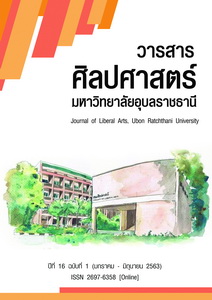Thai EFL Undergraduate Students’ Participation in Classroom Discussions
Main Article Content
Abstract
This study aimed to explore undergraduate EFL students’ participation in classroom discussions, as they provide not only opportunities for the students’ exposure to linguistic input and ability to produce output, but also a platform to develop critical thinking skill. This qualitative research analyzed the nature of students’ participation in classroom discussions and examined their reflections on the discussions. The participants were 25 undergraduate students majoring in English and communication at the Faculty of Liberal Arts, Ubon Ratchathani University, Thailand. These students took a mandatory course aiming to develop their research and critical thinking skills. The data was collected through classroom observations and interviews. Eight 3-hour class meetings were observed in their entirety and analyzed for characteristics of the students’ participation in both whole class and group discussions. Later, ten students were randomly selected for interviews, which sought to understand the students’ experiences in discussions. The analysis shows that classroom discussions encouraged students to share their understandings and thoughts on lessons. However, the degree of students' participation in classroom discussions was related to different characteristics including class size, question type, and topic of discussions as well as students’ individual differences. The findings also suggest that student-to-student and teacher-to-student relationships and students’ background knowledge contribute to the degree of engagement in classroom discussions.
Downloads
Article Details
References
Blatchford, P. & Baines, E. (2010). Peer relation in school. In K. Littleton, C. Wood and Kleine Staarman (Eds) International Handbook of Psychology in Education. Bingley, UK: Emerald.
Brookfield, S., & Preskill, S. (1999). Discussion as a way of teaching: Tools and techniques for democratic classrooms. San Francisco: Jossey-Bass Publishers.
Bui, H.Y.G. (2014). Task readiness: Theoretical framework and empirical evidence from topic Familiarity, strategic Planning, and proficiency levels. In: P. Skehan (Ed.), Processing perspectives on task performance (pp. 63–94). Amsterdam: John Benjamins.
Bygate, M., Skehan, P., & Swain, M. (2001). Introduction. In M. Bygate, P. Skehan, & M. Swain (Eds.), Researching Pedagogic Tasks: Second Language Learning, Teaching and Testing (pp. 1-20). New York: Pearson Education Limited.
Education First. (2019). The world's largest ranking of countries and regions by English skills. Retrieved from https://www.ef.co.th/epi/
Ewens, W. 2000. Teaching using discussion. In Classroom communication: Collected readings for effective discussion and questioning, ed. R. Neff and M. Weimer, 21–26. Madison, WI: Atwood Publishing.
Hamm, J. V., & Faircloth, B. S. (2005). The role of friendship in adolescents’ sense of school belonging. New Directions for Child and Adolescent Development, 2005(107), 61–78.
Hartup, W. W. (1992). Friendships and their developmental significance. In H. McGurk (Ed.), Childhood social development: Contemporary perspectives (p. 175–205). Lawrence Erlbaum Associates, Inc.
Hayes, D. (2008). Becoming a teacher of English in Thailand. Language Teaching Research, 12(4), 471–494.
Hayes, D. (2010). Language learning, teaching and educational reform in rural Thailand: an English teacher’s perspective. Asia Pacific Journal of Education, 30(3), 305–319.
King J. (2016) Introduction to the Dynamic Interplay between Context and the Language Learner. In: King J. (eds) The Dynamic Interplay between Context and the Language Learner. Palgrave Macmillan, London
Krashen, S. D. (1981). Second language acquisition and second language learning. Oxford: Pergamon Press.
Kulsirisawad, P. (2012) Students’ perceptions on the integration of peer feedback on grammatical errors in the EFL writing classroom. Manutsat Paritat: Journal of Humanities. Forthcoming 2012.
Long, M. H. (1983). Native speaker/non-native speaker conversation and the negotiation of comprehensible input. Applied Linguistics, 4, 126–141.
Long, M. H. (1996). The role of the linguistic environment in second language acquisition. In W. C. Ritchie & T. K. Bhatia (Eds.), Handbook of second language acquisition (pp. 413–468). New York: Academic Press.
Mackey, A. (1999). Input, interaction, and second language development: An empirical study of question formation in ESL. SSLA, 21, 557-587.
Mackey, A. (2012). Input, interaction, and corrective feedback in L2 learning. Oxford: Oxford University Press.
Mustapha, S. M., Rahman, N. S. N. A., & Md Yunus, M. (2010). Factors influencing classroom participation: A case study of Malaysian undergraduate students. In Procedia - Social and Behavioral Sciences, 9, 1079-1084
National Institute of Educational Testing Service. (2019). O-Net Statistic. Retrieved from https://www.niets.or.th/th/catalog/view/3865
Pica, T., Lincoln-Porter. F., Paninos, F. & Linnell, J. (1996). Language learners’ interaction: How does it address input, output and feedback needs of L2 learners? TESOL Quarterly 30(1), 59-84
Rujivanarom, P. (2016). School system’s failure to teach logical thinking linked to low PISA scores. The Nation. Retrieved from http://tinyurl.com/ l68ugux
Stone, G. (2017). Implementation of Critical Literacy for English Writing Classes in the Thai Context. The New English Teacher, (11)2, 65-76.
Swain, M. (1985). Communicative competence: Some rules of comprehensible input and comprehensible output in its development. In S. Gass, & C. Madden (Eds.), Input in second language acquisition (pp. 235-253). Rowley, MA: Newbury House.
Swain, M., & Lapkin, S. (1995). Problems in Output and the Cognitive Processes They Generate: A Step towards Second Language Learning. Applied Linguistics, 16, 371-391.
Vygotsky, L. S. (1987). Thinking and speech. In R. W. Rieber & A. S. Carton (eds.)., The collected works of L. S.
Vygotsky, L. S. (1962). Thought and Word. In L. Vygotsky & E. Hanfmann, G. Vakar (Eds.), Studies in communication. Thought and language (p. 119–153). MIT Press.
Weaver, R. R., & Qi, J. (2005). Classroom Organization and Participation: College Students’ Perceptions. The Journal of Higher Education, 76(5), 570–601.
Witherspoon, M., Sykes, G., and Bell, C. (2016). Leading a Classroom Discussion: Definition, Supportive Evidence, and Measurement of the ETS National Observational Teaching Examination (NOTE) Assessment Series (Research Memorandum No. RM-16-09). Princeton, NJ: Educational Testing Service.

